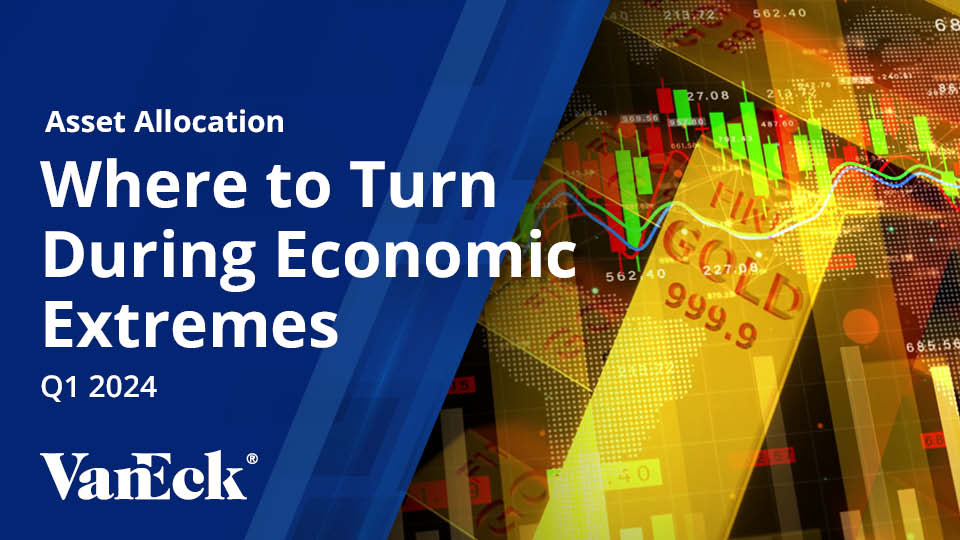Bull Trap Alert: Low Breadth & Violent Rallies
April 20, 2023
Read Time 7 MIN
Please note that VanEck may have a position(s) in the name(s) described below.
The VanEck Multi-Asset Solutions (“MAS”) team manages asset allocation portfolios across a wide range of asset classes. Our research process is based on a combination of quantitative and fundamental analysis. While no events are exactly alike, the lessons learned from past events can provide us with a roadmap for navigating the current environment.
This commentary focuses on our current views on the economy and asset allocation.
Macroeconomic Overview
There is an old story of a little Dutch boy who attempts to save his village from being flooded by plugging a hole in the leaking levee with his finger. In our adaptation, Federal Reserve (Fed) Chairman Jerome Powell is that little Dutch boy and the U.S. economy is his village. The sources of the immense water pressure causing cracks in our economy are high inflation, leading to high-interest rates and too much debt. Rates have been raised at the fastest pace since the great inflation of the 1970s, from 0.25% to 5% in one year. The intended results of these higher rates are to reduce aggregate demand and “starve out” inflation. The unintended consequences are further “cracks” that we have lately been experiencing.
Here is our running list of “cracks” or recently “failed” banks:
- Silicon Valley Bank (founded October 1983)
- Signature Bank (founded May 2001)
- Credit Suisse (founded July 1856)
To contain contagion risks, the depositors in the “failed” U.S. banks were fully backstopped by the government. The magnitude of the generosity of U.S. citizens can be seen in the rapid expansion of the Federal Reserve’s balance sheet in mid-March.
The Federal Reserve's Balance Sheet Rose Sharply in March
Source: Bloomberg. As of 3/30/2023.
It would be laughable to argue that financial austerity/future belt-tightening alone can pay that bill (and the massive pile of other bills). Instead, we will just have to shout to the barkeeper: “Put it on my tab!” Eventually, we will have to pay for them all in unexpected and uncomfortable ways, such as lower future growth and/or inflation. But, of course, that’s not a problem today. For now, though, it’s a case of: “Barkeeper! Another round, please!”
Our position has long been that the Fed will eventually pivot on interest rates and choose financial stability over price stability. If the recent bank failures were one-offs and not just the first dominoes to fall, the Fed should be able to keep rates elevated to maintain its inflation fight. However, that seems unlikely. It is more likely that additional “cracks” will continue to appear across the economy. This will further weaken our fragile economy and eventually force the Fed to pivot.
Inflation is currently falling, and we expect this trend to continue over the near term. The March Consumer Price Index (“CPI”) report showed a headline month-over-month increase of 0.1% and a year-over-year increase of 5%. However, the recent weakness was due to volatile energy and used car prices. Since the last report, the price of oil is now back above $80 per barrel as OPEC+ announced that it would cut production by 1.6 million barrels per day.
Do not be fooled by the volatility of inflation! We will not know if this inflation regime is finished until many years from now. We expect inflation to remain elevated, on average, at 3-5%, for an extended period of time, but with deflationary pockets. We are currently in such a pocket. Our long-term view on elevated inflation is based on structural supply and demand imbalances, most notably in the commodity markets, that are unlikely to be quickly resolved. History teaches us that inflation comes in waves and lasts a very long time. Here are charts of the previous two major inflation regimes in the U.S.
Two Major Periods of Inflationary Regimes in the U.S.: (1940 – 1951) and (1965 – 1995)
Source: BLS. As of 10/31/2017. Past performance is no guarantee of future results.
Both of those events, while different from each other, do share some similarities with today. The inflation of the 1940s was due to the broad money supply increases used to fund industrialization and WWII. Alternatively, the inflation of the 1970s was primarily driven by commodity shortages and social spending. Does any of this sound familiar?
The recent bank “failures” add pressure on the Fed to pivot on its fight against inflation and increases the likelihood of a recession in late 2023. The recession’s severity will depend mainly on the Fed’s policy actions going forward.
Asset Allocation
The S&P 500® Index was up 7.5% in the first quarter of this year thanks to the extreme performance of growth stocks. Two examples of growth stocks that drove the S&P 500 Index higher during this period were Tesla (+68%) and Meta (+76%). Yet the more value-sensitive sectors, such as energy, financial, healthcare, and utilities, were down over the quarter. The low market breadth and a violent rally in heavily beaten-down assets scream “bull trap.”
Current views:
- Stocks offer opportunities in the value segments of the market that can either maintain or even expand profit margins during high inflation. These include natural resource equities, infrastructure, and even short-duration REITs. The recent outperformance of growth over value (+12% year-to-date) offers an opportunity to rotate from growth into these segments tactically.
- Bonds rallied, and yields fell in March due to the turmoil in regional banks. Last month, the 10-year U.S. Treasury bond yield fell from over 4% to 3.37%. Yet, we remain in the most attractive yield environment in over a decade. Based on current yields and our outlook for falling interest rates, we are bullish on fixed income. However, a recession will likely bring widening credit spreads. So, be careful! Long-term treasuries, in our view, offer a solid hedge to barbell risk and maintain exposure to the more credit-sensitive segments of the bond market.
- Commodities, in aggregate, have underperformed stocks by over 10% on a one-year and year-to-date basis, despite significant inflationary pressures and long-term structural supply and demand imbalances. Therefore, this may offer an attractive entry point. Additionally, and as one example, the recent output cuts from OPEC+ are bullish for oil prices. The oil futures curves are in backwardation, another bullish indicator confirming our view on the near-term supply issues. While an economic downturn would reduce aggregate demand, supply issues are expected to support prices.
- Gold prices are now near all-time highs, and we expect gold to go much higher, eventually, as financial conditions deteriorate later in the year. Given the recent price strength, near-term price weakness is expected, and a pullback may offer a more attractive entry point. And if our macroeconomic outlook proves incorrect, gold remains an excellent portfolio diversifier!
- Bitcoin started the year just under $17k and is now above $30k! Bitcoin and other digital assets rallied in the first quarter and picked up momentum during the banking crisis in March. Is this a sign that the Bitcoin bulls were correct and, because it is rallying with gold, it is a store of value asset? Unlikely. The chart below demonstrates that, since 2020, there has been a significant uptick in the correlations of growth stocks, as measured by FAANG, and the price of Bitcoin.
Rolling 180-Day Correlation of FAANG stocks vs. Bitcoin
Source: Bloomberg. As of 3/31/2023. Past performance is no guarantee of future results.
Growth stocks and Bitcoin rallied in March as interest rates fell due to macroeconomic concerns. We are excited about the long-term potential for Bitcoin and other digital assets but are bearish in the near term. We expect Bitcoin and other digital assets to resume their correction, with growth stocks, in the coming months.
Thank you for taking the time to read our commentary. Each month we will provide our thoughts on recent market developments and offer our views on asset allocation to help you successfully navigate the environment.
For those interested in MAS-managed investment solutions, we encourage you to consider the VanEck Inflation Allocation ETF (RAAX), the VanEck Commodity Strategy ETF (PIT), the VanEck Dynamic High Income ETF (INC).
To receive more Asset Allocation insights, sign up in our subscription center.
Related Topics
Related Insights
February 28, 2024
February 22, 2024
December 19, 2023
Important Disclosures
This is not an offer to buy or sell, or a solicitation of any offer to buy or sell any of the securities mentioned herein. The information presented does not involve the rendering of personalized investment, financial, legal, or tax advice. Certain statements contained herein may constitute projections, forecasts and other forward-looking statements, which do not reflect actual results. Information provided by third–party sources are believed to be reliable and have not been independently verified for accuracy or completeness and cannot be guaranteed. Any opinions, projections, forecasts, and forward–looking statements presented herein are valid as of the date of this communication and are subject to change without notice. The information herein represents the opinion of the author(s), but not necessarily those of VanEck or its employees.
Consumer Price Index (CPI) is an index of the variation in prices paid by typical consumers for retail goods and other items.
The S&P 500® Index consists of 500 widely held common stocks covering industrial, utility, financial and transportation sector; as an Index, it is unmanaged and is not a security in which investments can be made.
The S&P 500 Index is a product of S&P Dow Jones Indices LLC and/or its affiliates and has been licensed for use by Van Eck Associates Corporation. Copyright © 2023 S&P Dow Jones Indices LLC, a division of S&P Global, Inc., and/or its affiliates. All rights reserved. Redistribution or reproduction in whole or in part are prohibited without written permission of S&P Dow Jones Indices LLC. For more information on any of S&P Dow Jones Indices LLC’s indices please visit www.spdji.com. S&P® is a registered trademark of S&P Global and Dow Jones® is a registered trademark of Dow Jones Trademark Holdings LLC. Neither S&P Dow Jones Indices LLC, Dow Jones Trademark Holdings LLC, their affiliates nor their third party licensors make any representation or warranty, express or implied, as to the ability of any index to accurately represent the asset class or market sector that it purports to represent and neither S&P Dow Jones Indices LLC, Dow Jones Trademark Holdings LLC, their affiliates nor their third party licensors shall have any liability for any errors, omissions, or interruptions of any index or the data included therein.
VanEck Inflation Allocation ETF (RAAX): An investment in the Fund may be subject to risks which include, among others, risks related to investing in real assets ETPs, which may subject the Fund to commodities, gold, natural resources companies, MLPs, real estate sector, infrastructure, ETP-related equity securities, small- and medium-capitalization companies, foreign securities, emerging market issuers, ETP-related foreign currency, credit, interest rate, call, concentration and derivative risks, all of which may adversely affect the Fund. The Fund may also be subject to fund of funds, affiliated fund, U.S. Treasury Bills, subsidiary investment, commodity regulatory (with respect to investments in the Subsidiary), tax (with respect to investments in the Subsidiary), cryptocurrency, cryptocurrency tax, liquidity (with respect to commodities instruments), gap, cash transactions, high portfolio turnover, models and data, active management, operational, authorized participant concentration, no guarantee of active trading market, trading issues, market, fund shares trading, premium/discount and liquidity of fund shares, and non-diversified risks. Foreign investments are subject to risks, which include changes in economic and political conditions, foreign currency fluctuations, changes in foreign regulations, and changes in currency exchange rates which may negatively impact the Fund's returns. Small- and medium-capitalization companies may be subject to elevated risks.
VanEck Commodity Strategy ETF (PIT): An investment in the Fund may be subject to risks which include, among others, commodities and commodity-linked instruments and tax, futures contract, U.S. Treasury Bills, subsidiary investment, commodity regulatory, subsidiary tax, gap, cash transactions, liquidity, high portfolio turnover, active management, credit, interest rate, derivatives, counterparty, pooled investment vehicle, repurchase agreements, regulatory, affiliated fund, market, operational, authorized participant concentration, new fund, absence of prior active market, trading issues, fund shares trading, premium/discount, liquidity of fund shares, non-diversified, concentration, municipal securities, money market funds, securitized/asset-backed securities, and sovereign bond risks, all of which may adversely affect the Fund.
VanEck Dynamic High Income ETF (INC): An investment in the Fund may be subject to risks which include, among others, fund of funds, ETPs, U.S. treasury securities, interest rate, income, high portfolio turnover, management, operational, authorized participant concentration, absence of prior active market, trading issues, market, fund shares trading, premium/discount, liquidity of fund shares, affiliated fund, new fund, and non-diversified risks. The Fund may also be subject to dividend paying securities, investing in foreign securities, investing in emerging market issuers, foreign currency, investing in mortgage REITs, preferred securities, CLO, credit, high yield securities, interest rate, call and concentration risks, all of which may adversely affect the Fund.
Investing involves substantial risk and high volatility, including possible loss of principal. An investor should consider the investment objective, risks, charges and expenses of the Fund carefully before investing. To obtain a prospectus and summary prospectus, which contains this and other information, call 800.826.2333 or visit vaneck.com. Please read the prospectus and summary prospectus carefully before investing.
© 2023 Van Eck Securities Corporation, Distributor, a wholly owned subsidiary of Van Eck Associates Corporation.
Related Funds
Important Disclosures
This is not an offer to buy or sell, or a solicitation of any offer to buy or sell any of the securities mentioned herein. The information presented does not involve the rendering of personalized investment, financial, legal, or tax advice. Certain statements contained herein may constitute projections, forecasts and other forward-looking statements, which do not reflect actual results. Information provided by third–party sources are believed to be reliable and have not been independently verified for accuracy or completeness and cannot be guaranteed. Any opinions, projections, forecasts, and forward–looking statements presented herein are valid as of the date of this communication and are subject to change without notice. The information herein represents the opinion of the author(s), but not necessarily those of VanEck or its employees.
Consumer Price Index (CPI) is an index of the variation in prices paid by typical consumers for retail goods and other items.
The S&P 500® Index consists of 500 widely held common stocks covering industrial, utility, financial and transportation sector; as an Index, it is unmanaged and is not a security in which investments can be made.
The S&P 500 Index is a product of S&P Dow Jones Indices LLC and/or its affiliates and has been licensed for use by Van Eck Associates Corporation. Copyright © 2023 S&P Dow Jones Indices LLC, a division of S&P Global, Inc., and/or its affiliates. All rights reserved. Redistribution or reproduction in whole or in part are prohibited without written permission of S&P Dow Jones Indices LLC. For more information on any of S&P Dow Jones Indices LLC’s indices please visit www.spdji.com. S&P® is a registered trademark of S&P Global and Dow Jones® is a registered trademark of Dow Jones Trademark Holdings LLC. Neither S&P Dow Jones Indices LLC, Dow Jones Trademark Holdings LLC, their affiliates nor their third party licensors make any representation or warranty, express or implied, as to the ability of any index to accurately represent the asset class or market sector that it purports to represent and neither S&P Dow Jones Indices LLC, Dow Jones Trademark Holdings LLC, their affiliates nor their third party licensors shall have any liability for any errors, omissions, or interruptions of any index or the data included therein.
VanEck Inflation Allocation ETF (RAAX): An investment in the Fund may be subject to risks which include, among others, risks related to investing in real assets ETPs, which may subject the Fund to commodities, gold, natural resources companies, MLPs, real estate sector, infrastructure, ETP-related equity securities, small- and medium-capitalization companies, foreign securities, emerging market issuers, ETP-related foreign currency, credit, interest rate, call, concentration and derivative risks, all of which may adversely affect the Fund. The Fund may also be subject to fund of funds, affiliated fund, U.S. Treasury Bills, subsidiary investment, commodity regulatory (with respect to investments in the Subsidiary), tax (with respect to investments in the Subsidiary), cryptocurrency, cryptocurrency tax, liquidity (with respect to commodities instruments), gap, cash transactions, high portfolio turnover, models and data, active management, operational, authorized participant concentration, no guarantee of active trading market, trading issues, market, fund shares trading, premium/discount and liquidity of fund shares, and non-diversified risks. Foreign investments are subject to risks, which include changes in economic and political conditions, foreign currency fluctuations, changes in foreign regulations, and changes in currency exchange rates which may negatively impact the Fund's returns. Small- and medium-capitalization companies may be subject to elevated risks.
VanEck Commodity Strategy ETF (PIT): An investment in the Fund may be subject to risks which include, among others, commodities and commodity-linked instruments and tax, futures contract, U.S. Treasury Bills, subsidiary investment, commodity regulatory, subsidiary tax, gap, cash transactions, liquidity, high portfolio turnover, active management, credit, interest rate, derivatives, counterparty, pooled investment vehicle, repurchase agreements, regulatory, affiliated fund, market, operational, authorized participant concentration, new fund, absence of prior active market, trading issues, fund shares trading, premium/discount, liquidity of fund shares, non-diversified, concentration, municipal securities, money market funds, securitized/asset-backed securities, and sovereign bond risks, all of which may adversely affect the Fund.
VanEck Dynamic High Income ETF (INC): An investment in the Fund may be subject to risks which include, among others, fund of funds, ETPs, U.S. treasury securities, interest rate, income, high portfolio turnover, management, operational, authorized participant concentration, absence of prior active market, trading issues, market, fund shares trading, premium/discount, liquidity of fund shares, affiliated fund, new fund, and non-diversified risks. The Fund may also be subject to dividend paying securities, investing in foreign securities, investing in emerging market issuers, foreign currency, investing in mortgage REITs, preferred securities, CLO, credit, high yield securities, interest rate, call and concentration risks, all of which may adversely affect the Fund.
Investing involves substantial risk and high volatility, including possible loss of principal. An investor should consider the investment objective, risks, charges and expenses of the Fund carefully before investing. To obtain a prospectus and summary prospectus, which contains this and other information, call 800.826.2333 or visit vaneck.com. Please read the prospectus and summary prospectus carefully before investing.
© 2023 Van Eck Securities Corporation, Distributor, a wholly owned subsidiary of Van Eck Associates Corporation.



